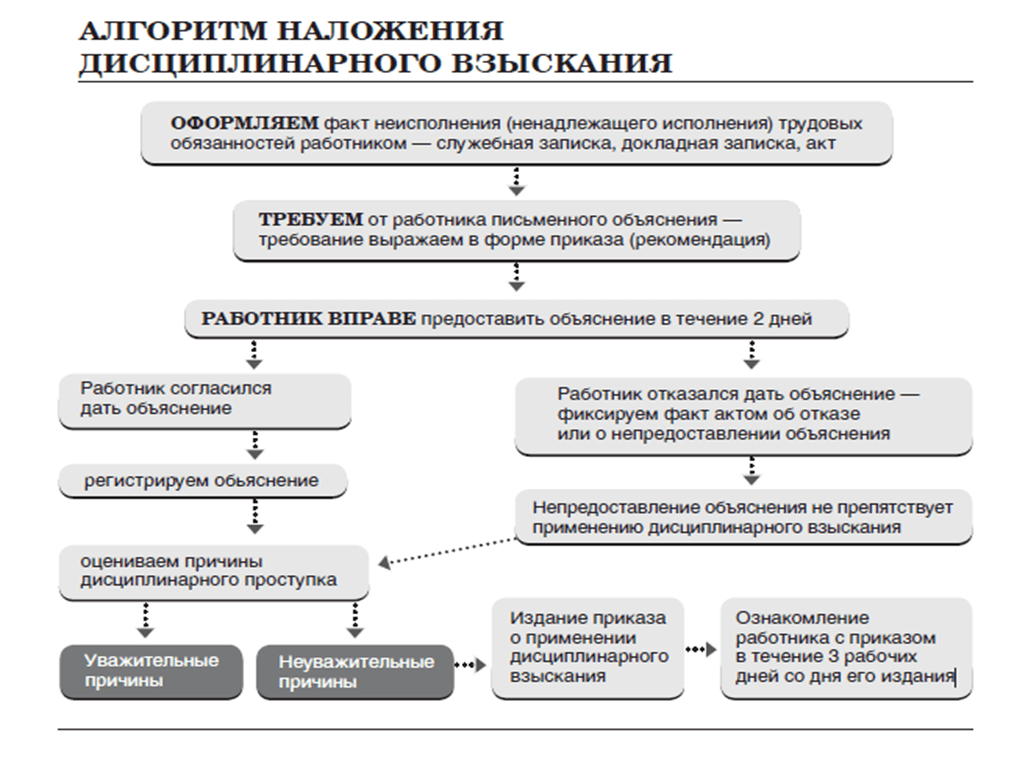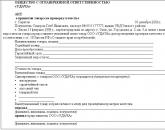Labor moments: terms for imposing a disciplinary sanction
Employment relations include several aspects, among which it occupies not the last place. If it is violated, such a concept as “negligence” is introduced into legal relations. Irresponsible attitude to one's official duties is subject to punishment - disciplinary action.
Dear readers! The article describes typical ways of how to solve legal problems. Your case is individual.
This measure allows you to regulate labor relations, keep them within the law. , like any other punishment, can be appealed. And the imposition of this punishment is associated with several important nuances that both employers and employees should be aware of.
Violation of labor discipline as a reason for imposing a disciplinary sanction
The Labor Code of the Russian Federation regulates the procedure and rules for imposing a disciplinary sanction. In the same document, you can see the rules for processing documents (articles 193 - 195):
- Firstly, when a violation of labor discipline is detected, the person who performs managerial duties in relation to an employee caught in negligence writes a report in which he indicates all the circumstances of the incident (for example, the site manager writes to the director).
- Secondly, the head of the entire enterprise requires an explanatory note from the violator of labor discipline. He, in turn, must state his point of view on what happened, tell about all the circumstances that led to neglect of duties, for example, absenteeism.
Further, the course of the case depends on whether the offender writes an explanatory note or not. If he does not write (refuses officially or simply ignores the requirements silently), the management needs to draw up an act of refusal to provide an explanatory note.
If an explanatory note is provided, the manager must consider and analyze all the circumstances of the incident. If the case is difficult, you can. Sometimes it is necessary to involve other specialists for consultation or to conduct audits. Specific actions depend on the nature of the violation.

Imposition of a disciplinary sanction: schematic
When everything is clarified, the head issues an order to impose a disciplinary sanction. They may be reprimanded, in more serious circumstances -. In the most severe cases, dismissal occurs. Then the violator is invited to sign that he has read the order. If he refuses to sign, it will be necessary for the head to draw up an act about this.
After a certain period of time, the person who received the penalty may apply in writing to request the removal of the penalty. To do this, you just need to make an application in any form.
To strengthen the legal impact on the management, you can attach a petition from the trade union committee or your immediate supervisor to the application. Subject to labor discipline, a careful and responsible attitude to business, it will not be difficult to obtain such a document from colleagues.
The main stages of imposing a penalty and compiling the necessary documents are listed above. Each of these steps has its own time of action, its own terms. When the period specified in the law expires, all actions taken will be considered inconsistent with the law (void).
If it is not possible to remove the penalty ahead of schedule (upon an application, petition), the imposed penalty will be automatically removed after the expiration of the period.
The video material will acquaint you with the procedure for imposing a disciplinary sanction:
Key dates
After a case of violation of labor discipline, the manager is given a month to carry out actions related to the imposition of a disciplinary sanction. The countdown starts from the day or even the moment when there was a negligent attitude to duties. But this period is extended in the case when the person convicted of the violation is, because you can be on vacation for more than a month.
The time frame for familiarizing the employee who has been sanctioned with the order is 3 days. Within 3 working days after the order is issued, the employee must sign this document. If the employee was informed of the need to familiarize himself with the order and sign, but refused to do so, then the manager is obliged to draw up an act on this.
Writing an explanatory note in which the employee sets out his vision of the situation also has its own time frame. It can be written at any time, but no later than the issuance of the order. So first an explanatory note, then an order.
If the perpetrator of negligence does not come to work, then he must be officially notified of the need to give explanations in writing. For this, the possibility of sending a telegram is provided.
If a person refused to write an explanatory note or simply ignored the requirements, then after a 2-day period, an act of refusal is drawn up.

Disciplinary penalties vary
If the employee believes that the violation occurred because he was not able to perform his duties as he should, for example, he was late, absenteeism, must prove this. For example, provide a certificate from a medical institution.
If absenteeism was due to the performance of state duties, then this fact must also be documented (for example, to the court).
If the employee in the explanatory note speaks about the absence of intent in the committed actions, then this will also need to be documented or with the involvement of witnesses.
Using these nuances, some successfully avoid disciplinary action. For example, if an employee did not want to perform the task given to him and simply left work, then he will not be able to impose any penalty if he later brings a certificate from the blood transfusion station, which states that he donated blood that day, which means he was released from work.
All documents related to the issuance of disciplinary sanctions must be archived for at least 5 years. A specific list, reflecting how long certain documents should be in the archive, is in the "List of standard management documents generated in the activities of organizations, indicating the periods of storage" (06.10.2000). according to this document, some papers should be kept for 75 years.
How to withdraw a charge?
![]()
Disciplinary action can be challenged in court
The charge is removed without any action after 1 year. The fact is that this is the validity period of any penalty. However, such time frames are relevant only if the year has passed without violations.
If more cases of negligence have been identified, then the whole process starts over, and the duration of the penalty is extended from the moment the last order is issued.
Anyone can appeal against the order to collect in court. In this case, the courts will take into account the terms in which the execution of the relevant documents took place, when the penalties were issued, when they expired, and other points.
So, if you want to punish a negligent employee, the manager must strictly follow the law, comply with all deadlines, carefully work with documents, and involve relevant specialists for consultations. Otherwise, he will not succeed, and the violator will continue to ignore his official duties.
Noticed an error? Select it and click Ctrl+Enter to let us know.
Popular
- How to get a TIN: possible ways
- What kind of business can you do?
- Written notice of termination of the lease
- Business from scratch. Things to do?
- Cost of goods sold: formula, methodology and calculation example
- How to write a vacation application - examples
- What kind of business can be opened in a small town or village?
- The formula for calculating the cost of services, products sold and total cost
- Sample memorandum: I bring to your attention
- Example of an explanatory note for being late for work




